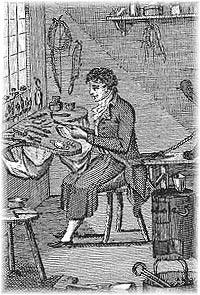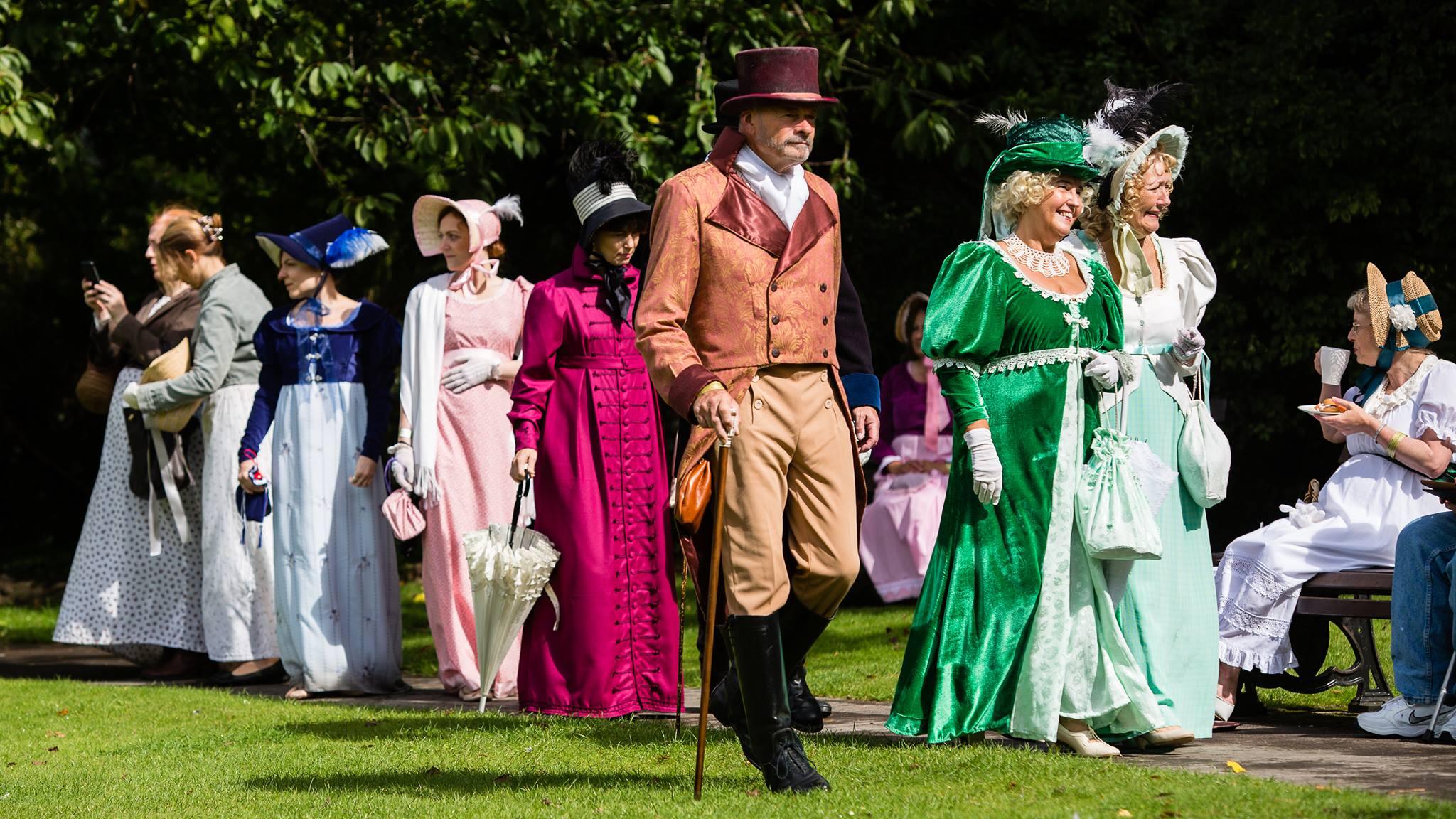Article: The Jeweller : A Regency Profession

The Jeweller : A Regency Profession
 Who made Regency jewellery? It appears from history that the profession of a jeweller is of very ancient date; for we read in the Bible that Aaron had a breast-plate set with a variety of precious stones: and in succeeding ages there is frequent mention of rings and other ornaments being made of gold and set with stones. Hence the name jeweller, one who sets jewels, or precious stones, is properly derived.
Who made Regency jewellery? It appears from history that the profession of a jeweller is of very ancient date; for we read in the Bible that Aaron had a breast-plate set with a variety of precious stones: and in succeeding ages there is frequent mention of rings and other ornaments being made of gold and set with stones. Hence the name jeweller, one who sets jewels, or precious stones, is properly derived.
The name jeweller is now commonly applied to all who set stones, whether real or artificial; but, properly speaking, it belongs only to those who set diamonds and other precious gems.
According to the general application of the term, jewellers make rings of all sorts in gold, lockets, bracelets, broaches, ornaments for the head, earrings, necklaces, and a great variety of trinkets composed of diamonds, pearls, or other stones. The DIAMOND was called by the antients adamant: as a precious stone, it holds the first rank, in value, hardness, and lustre and weight, of all gems. The goodness of diamonds consists in their water, or colour, lustre and weight. The most perfect colour is the white. The defects in diamonds are veins, flaws, specks of red and black sand, and a blueish or yellowish cast.
In Europe, lapidaries examine the goodness of their diamonds by daylight, but in the Indies they do it by night: for this purpose a hole is made in the wall, where a lamp is placed, with a thick wick, by the light of which they judge of the goodness of the stone. Diamonds are found in the East Indies, principally in the kingdoms of Golconda, Visapour, Bengal, and the island of Borneo. They are obtained from mines and rivers. As the diamond is the hardest of all precious stones, it can only be cut and ground by itself and its own substance.
To bring diamonds to that degree of perfection which augments their price so considerably, the workmen rub several against each other; and the powder thus rubbed off the stones, and received in a little box for the purpose, serves to grind and polish others. The PEARL is a hard, white, smooth, shining body, found in shellfish resembling an oyster, and is ranked among the gems.
The perfection of pearls, whatever be their shape, consists chiefly in the lustre and clearness of their colour, which jewellers call their water. Those which are white are the most esteemed in Europe; while many Indians and the Arabs prefer the yellow: some are of a lead colour; some border on the black, and some are quite black. The oriental pearls are the finest, on account of their largeness, colour, and beauty, being generally of a beautiful silver white: those found in the western hemisphere are more of a milk-white.
In Europe pearls and diamonds are sold by carat weight, the carat being equal to four grains; but in Asia, the weights made use of are different in different states.  In the print we have a man at work, who will represent either a jeweller, or a small worker in silver; one who makes rings, perfume-boxes, &c. The board at which he works is adapted also for a second workman. The leathern skins fastened to the board are to catch the filings and small pieces of precious metals, which would otherwise be liable to fall on the ground.
In the print we have a man at work, who will represent either a jeweller, or a small worker in silver; one who makes rings, perfume-boxes, &c. The board at which he works is adapted also for a second workman. The leathern skins fastened to the board are to catch the filings and small pieces of precious metals, which would otherwise be liable to fall on the ground.
The tools on the board, and in the front under the window, are chiefly files of various kinds, and drills; beside which there is a small hammer, a pair of pliers, and, on a little block of wood, a small crucible. On his left hand above the board is a drill bow: this is a flexible instrument, consisting of a piece of steel, to the ends of which is fastened a cat-gut: the cat-gut is twisted round one of the drills which stand before the man, and then it is fitted for his business. Behind him is fixed the drawing-bench, on which he draws out his wire to any degree of fineness.
The method of drawing wire from gold or other metals is this: The metal is first made into a cylindric form; when it is drawn through holes of several irons, each smaller than the other, till it be as fine as it is wanted, sometimes much smaller than a hair. Every new hole lessens its diameter; but it gains in length what it loses in thickness: a single ounce is frequently drawn to a length of several thousand feet. In the front of the plate is represented a German stove, which is rarely used for any other purpose than that of heating the shop: for jewellers cannot work in winter, unless the temperature of the shop be pretty high. At the top of the stove is a crucible, and on the floor is another: these are useful for many purposes; they are not however heated in the stove, but in a forge, which is an essential article in a jeweller's shop, though not exhibited in the plate.
Another very material tool found in every jeweller's work-room is the anvil and block. A flatting-mill is also wanted, and indeed cannot be dispensed with where the business is considerable. The flatting-mill consists of two perfectly round and very highly polished rollers, formed internally of iron, and welded over with a plate of refined steel: the circumferences of these rollers nearly touch each other; they are both turned with one handle. The lowermost roller is about ten inches in diameter, and the upper one is much smaller. The wire that is to be flattened, unwinding from a bobbin, and passing through a narrow slit in an upright piece of wood, called a ketch, is directed by a small conical hole in a piece of iron, called a guide, to any particular width of the rollers; some of which, by means of this contrivance, are capable of receiving forty threads.
After the wire is flatted, it is again wound on a bobbin, which is turned by a wheel, fixed on the axis of one of the rolls, and so managed that the motion of the bobbin just keeps pace with that of the rolls. Besides those which are already mentioned, jewellers require a great variety of other tools; such as gravers, scorpers, spit-stickers, knife-tools, straining-weights, brass-stamps, lamp and blow-pipe, ring-sizes, spring-tongs, piercing-saws, boiling-pans, shears, &c. &c.
The trade of a jeweller has always been considerable in London; but, like many others, it is very much affected by a war, and at this moment it is exceedingly flat. During the American war, thousands of that business were almost in a starving condition: those only who are capable of turning their genius to other mechanical pursuits are likely to obtain employment at such times. Some jewellers will earn as journeymen four guineas a week; but the general run of wages is about 28 or 80 shillings.
From "The Book of Trades, or Library of Useful Arts" published by Jacob Johnson, in 1807, with the original copper plate engraving.
If you don't want to miss a beat when it comes to Jane Austen, make sure you are signed up to the Jane Austen newsletter for exclusive updates and discounts from our Online Gift Shop.


Leave a comment
This site is protected by reCAPTCHA and the Google Privacy Policy and Terms of Service apply.